




































I’m si ing in Barcelona writing this issue’s editor’s note, trying to get my body clock adjusted to the 7-hour time difference between this amazing Spanish city and my home in Chicago while marveling at how easy technology has made it for Publisher Ed Avis and me to work and to explore the world simultaneously.
One of the first things we’ve noticed in just 3 days in Barcelona is the wealth of restaurants that line virtually every block in every part of the city we’ve visited — everything from tiny coffee and pastry shops to quick-serve empanada spots to sit-down tapas bars and upscale establishments. And from our limited observations, most of them appear quite full (many actually bustling at 2:30 p.m.) — that, in spite of the fact that so many concepts that appear to be competitors (at least from a cursory glance at menus posted outside) are co-existing on the same block, and sometimes right next door!
We’ve seen myriad restaurants that feature Spanish, Argentinian, Asian, Peruvian, and Italian cuisine. But we’ve only seen two so far that offer Mexican fare, and a quick online search shows that Mexican restaurants here focus on tacos — we’re on the lookout for more options.
We’ll be exploring the restaurant scene here, in Madrid, and in the southern town of Málaga over the next month and reporting back on our culinary adventures. Watch for highlights of interesting and unique dishes, cocktails and food and drink presentations that you might be able to adopt or adapt at your restaurant in our posts on Facebook, Instagram and at elrestaurante.com.

In the meantime, peruse this issue for ideas you can use as you enter the spring dining season and begin to prepare for summer. You’ll find great tips on making memorable Margaritas from Chicago’s El Mariachi Tequila Bar (whose Prickly Pear and Papaya Margaritas are featured on the cover); learn how restaurants are taking empanadas beyond basic meat and cheese varieties; and discover how to capitalize on the increasing popularity of conchas, which, according to a recent trends report, bakers and chefs are using in creative ways.
Enjoy the issue…and stay tuned for more from España!
PUBLISHER Ed Avis
EDITOR Kathleen Furore
ART DIRECTOR Ala Ennes
MAIN OFFICE phone: 708.267.0023
PRESS RELEASES TO: kfurore@restmex.com
MAILING ADDRESS P.O. Box 13347 Chicago, IL 60613
SHIPPING ADDRESS 1317 W. Belden Ave. Chicago, IL 60614
AD SALES/ENGLISH Ed Avis 708.218.7755 e davis@elrestaurante.com
Suzanne Bernhardt 678.880.9282 suzanne@elrestaurante.com
AD SALES/ESPAÑOL Alfredo Espinola 52-55-4006-9540 alfredo@elrestaurante.com
Published by
Maiden Name Press, LLC Volume 28, Number 2 el Restaurante (formerly el Restaurante Mexicano) (ISSN 1091-5885) is published six times a year by Maiden Name Press, LLC 1317 W. Belden Ave., Chicago, IL 60614
All contents copyright© 2025 Maiden Name Press, LLC. Nothing in this issue may be reproduced in any form without publisher’s consent.










Everyone wants real avocado, but nobody wants to waste their time, money or patience dealing with the real challenges of whole avocados.
WHOLLY® Avocado products give you a better deal:
• No need to wash, cut, pit or scoop.
• Easy to store with longer shelf life.
• Full yield, no food waste.

TALK TO AN AVOCADO EXPERT NEAR YOU

Recent headlines from across the country paint a concerning picture for the restaurant industry where immigration is concerned:
• In Texas: ICE, Homeland Security raid bakery, charge owners with harboring illegal immigrants
• In Tennessee: Tennessee Taco Truck Shares Shocking Footage of Suspected ICE Agents Raiding Their Vehicle, Questioning Workers
• In Kansas: After ICE raid, Liberty restaurant sees boost of customers, fundraising for 12 detained
• And in Florida: ICE raids having both direct, indirect impact on South Florida workers
As scenes like those play out throughout the country — and with the administration’s promise to further ramp up immigration raids nationwide — it is important for everyone to understand how to respond both before, during and after ICE agents pay a visit.

Well before any raid happens, make sure that your employees’ paperwork such as I-9 forms is in order, and that your employees are all legally employable. Work with an employment attorney if you have any doubts. Having a relationship with an immigration attorney who you can turn to if problems arise is also valuable. However, even if you believe you are totally in compliance, ICE could still raid your restaurant if they have evidence of individuals there who are not legally in the country. They also can raid if they receive a complaint about that issue from a customer or employee.
The American Business Immigration Coalition and Passage Immigration Law suggest taking these additional steps:
• Create a company-wide plan on how to properly respond to a raid and make sure everyone in the restaurant knows what it is.
• Give each employee a Know-Your-Rights card. Click here to access one.
• Appoint a point person, one per shift, who will speak with ICE agents if they arrive.
According to the American Business Immigration Coalition and to Passage Immigration Law, there are several ways to handle the situation if ICE agents show up at your restaurant:
• Be respectful. Even if the agents disagree with your assessment of what they can do, do not raise your voice or get into a physical altercation.
• Call your immigration attorney. Tell the agents it is company policy to do so. The attorney may be able to speak with the agents or even come to your restaurant immediately to take the lead.
• Get your “point person” involved. Have them speak with the ICE agents and politely refuse to discuss the immigration status of employees without an attorney present. If the agents ask employees to stand in certain areas based on immigration status, remind them they do not need to comply. They can stand still or move to a neutral spot.
• Don’t allow ICE agents into your restaurant’s private spaces. Agents can freely go into public spaces, but not into the office, staff break room, etc. unless they have a warrant. If they present a warrant, read it. Make sure it is signed and dated by a judge and take note of the scope of the warrant. For example, it should explain what documents can be seized.
• Remind your employees they have the legal right to remain silent. It is up to them whether they want to speak with the agents or not. They may ask for an attorney before they answer questions.
• Don’t try to hide employees or help them leave. Similarly, do not lie to the agents or provide false documentation, and do not interfere with the agents.
• Document the raid. Get the name of the supervising agent and the U.S. attorney assigned to the case. Make note of any documents that are taken. You may record the event from a safe and respectful distance. This information may help any employees who are detained.
• Inform family members of any employee who is taken by the agents. Make sure someone contacts them immediately and also pay them any wages owed.
Click here for more details, including the rights of employees (even undocumented employees).

A Sammic immersion blender makes your salsa preparation easier than ever! A powerful motor, easy-to-use controls and ergonomic design mean your staff can create amazing salsas, soups and other blended menu items with ease and speed. You will love the labor savings and your customers will love the results!

Are you proud of the salsa you make in your restaurant? Then put your salsa recipe to the test and enter the el Restaurante Sassiest Salsa Contest sponsored by Sammic!
Entering the contest is easy, and the prizes make it totally worth it: The creator of the first place recipe will receive a Sammic XM-52 Immersion Blender, the ultimate tool for mixing salsa! And the top three winners will get a cash prize: $750, $500 and $250, respectively. To top it off, all of the winning recipes will be used in our Recipe of the Week email program and be published in the Nov/Dec edition of el Restaurante

To enter the contest, click here and complete the form. The deadline is August 30, 2025. Your recipe needs to be an original creation, and remember that we’ll publish the winners, so don’t send us a recipe that you’re trying to keep secret. The recipes will be judged by experienced chefs and the winners will be announced in September.
Last year’s winners were particularly innovative. First place was Salsa Macha Negra by Chef Nick Belloni at Comedor in Austin. It is a powerful combination of chiles, seeds and garlic that pairs especially well with grilled vegetables. The second place winner was Salsa Medianoche by Justin Ward, director of culinary for Mad Dogs Restaurant Group, the parent of Casa Catrina in San Antonio. Ward’s recipe is loaded with chiles and garlic, offset by a bit of piloncillo and two cups of Negro Modelo beer. Third place was claimed by Passion Fruit Salsa Verde with Cotija by Darryl Holliday, executive director of the Arkansas Food Innovation Center at Market Center of the Ozarks. His recipe is distinguished by the addition of passionfruit and cotija. Click here to read about last year’s winners.
“We know how important great salsa is to a Mexican restaurant, and we are happy to continue supporting a contest that encourages chefs to create new salsa recipes,” says Neal Pearlman, sales director, North America, for Sammic, which also sponsored the contest in 2024. “And we know that Sammic immersion blenders are an essential tool for restaurants making their own salsa, so offering them as prizes for this contest made sense.”
To enter the contest, click here and complete the form. Good luck!


• Made from Premium Cuts of Chicken
• Authentic Mexican Flavor
• Expand Your Menu to Non-Pork and Beef Meat Eaters









JOHN IANNUCCI, CEO,

Mas Mex, the restaurant group behind Escalante’s Fine Tex Mex & Tequila and Fat Rosie’s Taco and Tequila Bar, has made expanding Fat Rosie’s a key part of its corporate strategy — and leading the way is John Iannucci, who took on the role of CEO in the summer of 2024.
Since his arrival, a new Fat Rosie’s debuted in Rosemont, Illinois, making it the sixth location in the concept’s portfolio. And there are plans to grow beyond the Chicago area.
How is the company thriving at a time when the restaurant industry is facing so many challenges — the lingering impact of Covid, a downturn in the economy, and now immigration and tariff issues? Here Iannucci shares his perspective with el Restaurante.
1How has Mas Mex been able to grow the Fat Rosie’s concept when other Mexican restaurants — chain and independents alike — are struggling?
Despite the challenges, our success comes down to one thing: an unwavering commitment to delivering an exceptional guest experience. We are maniacal about hospitality — laserfocused on service, atmosphere, and food quality. No matter
We can all learn something from each other. I’ve always found that being authentic and humble allows us to better the community and industry overall.
what obstacles arise, we stick to what got us here: creating an unforgettable experience at every opportunity.
At Fat Rosie’s, we don’t just serve food — we create moments. That’s what it means to be Fluent in Fiesta. It’s about ensuring that every guest feels like they’ve walked into a high-energy, celebratory space where they can let loose, have fun, and enjoy incredible food and drinks.
Being Fluent in Fiesta isn’t just a tagline — it’s an experience we deliver in specific, memorable ways:
• Service with personality Our team brings fun and flair to every table, making guests feel like they’re part of the Fat Rosie’s family.
• Unforgettable, Instagram-worthy moments We hand out sombreros to guests, setting the stage for lively, shareable photos.
• Elevated celebrations From birthdays to other important milestones that are important to our customers, we bring out shots from the bar in shot planes with sparklers, turning any occasion into an event.
• Live entertainment From Mariachi bands and DJs to live music on weekends, Fat Rosie’s is always buzzing with energy.
2As the number of Mexican restaurants grows nationwide, what makes Fat Rosie’s stand out from all the other concepts in the marketplace, especially in Chicago where there are so many Mexican concepts, many of them family-owned, single-unit independents that o ffer very authentic, traditional Mexican fare?
Fat Rosie’s isn’t just a Mexican restaurant. It’s a destination for celebration. While we take pride in serving authentic dishes and award-winning margaritas, what truly sets us apart is the high-energy, immersive experience we create every day.

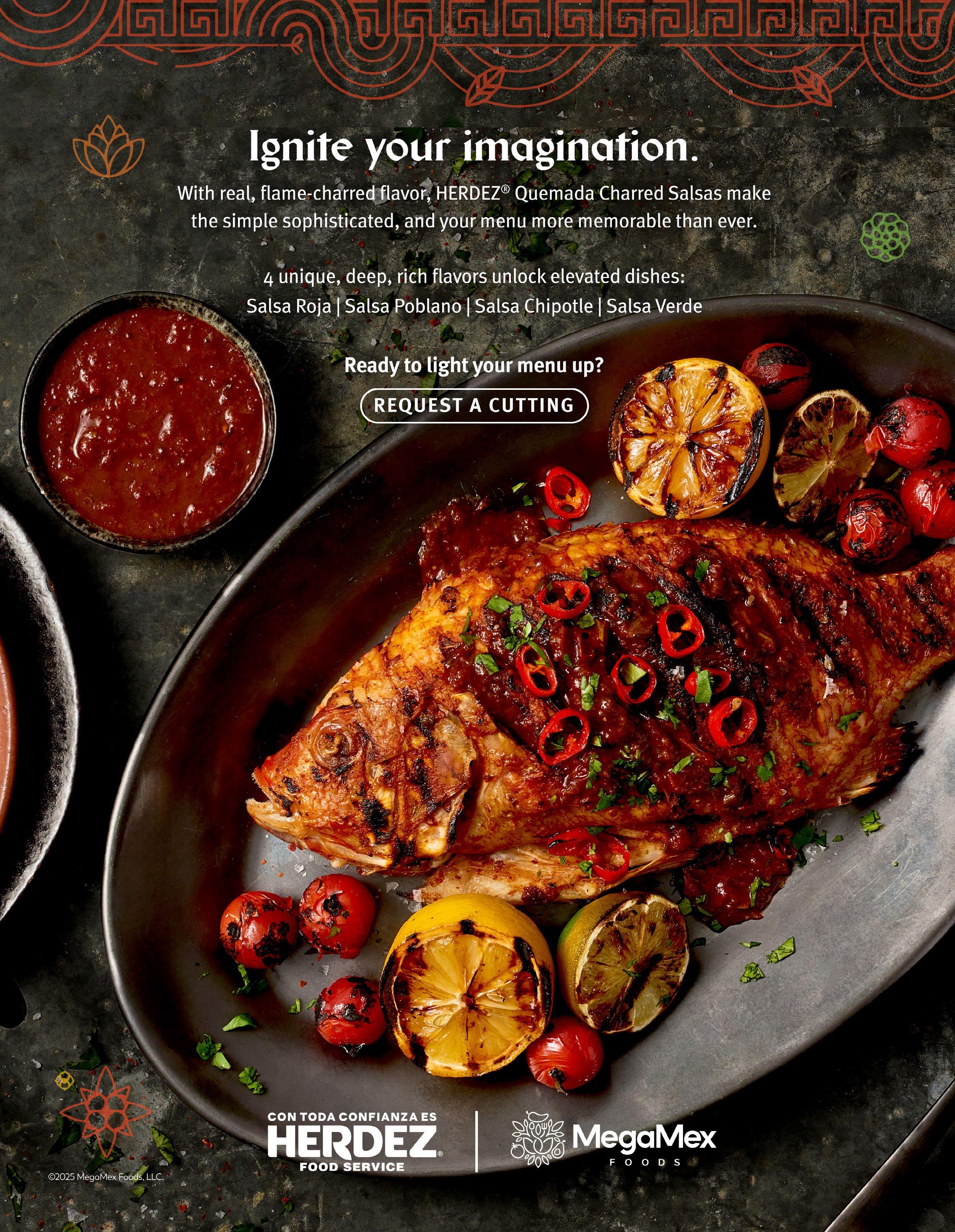
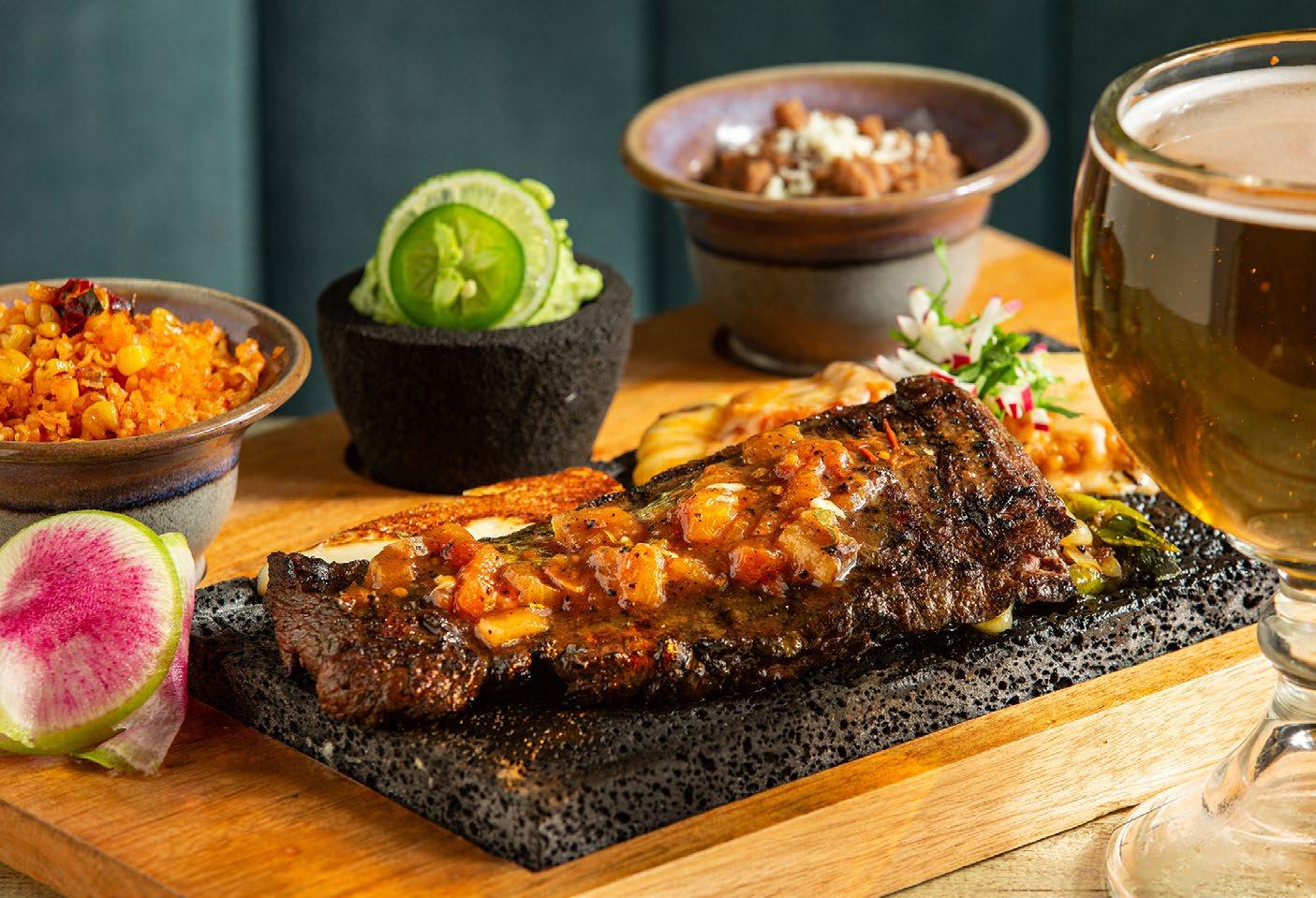
Our team is empowered to make guests feel like they’re at a party, surrounded by friends and family. While other restaurants [might] focus on discounts, we double down on experience — ensuring every guest walks away with a memorable celebration that keeps them coming back.
3
I’m sure many of those small restaurants don’t relish having a big, regional chain expand in their market. What is your take on why and how they can successfully co-exist with brands like Fat Rosie’s?
Each one of us is different in many ways, yet similar in many ways, too. We can all learn something from each other. I’ve always found that being authentic and humble allows us to better the community and industry overall. We hope to be able to spread the word about not only authentic Mexican cuisine but also to bring more people into the community and educate them on the culture and restaurant space overall.
4
Many restaurants have found it di ffi cult to control costs in light of inflation. And they’re finding it tough to raise prices enough to balance that out without losing customers who don’t want to or can’t pay higher prices. How do you address that situation at Mas Mex?
Specific to rising costs, we use technology and have systems in place to control waste, order product, prep product, etc. in order to not pass the rising costs of goods onto the guest.
Controlling waste and forecasting the business volumes properly are two specific areas that we try and stay ahead on.
We have excellent relationships with our vendors and work with them ahead of time on potential headwinds. We also work very hard overall to source items ahead of time and look at buying products that may be affected in bulk. Controlling waste and forecasting the business volumes properly are two specific areas that we try and stay ahead on.
5
What advice do you have for a small, single-unit independent that is considering adding a location? What are some of the first things they should do? The biggest advice I can give is to prove out the first unit to make sure it can play during times of good and bad. After that, identifying the next market or part of the community that you want to go into is key. It starts with site selection. What is the traffic like during the day and at night where you want to go? What about during the week and weekends? What are the income levels and demographics like within a mile, 3 miles, 5 miles, etc.? Real estate is so important and finding an “A” type of site is critical to growth especially for location #2!



|
BY KATHLEEN FURORE |
Several years ago, Tony Estrada and his family introduced a Cucumber Jalapeño Margarita with watermelon and basil at Revolución Mexican Steakhouse — one of three restaurants he, his late dad Antonio and brother Adrian owned in Chicago’s Lakeview neighborhood. At that time, the cocktail was unique — but soon it became a fairly common offering on bar menus.
“We were one of the first to do it, but now it’s everywhere,” says Estrada of the drink created at the now-shuttered steakhouse.
Remnants of that cocktail survived in the creative, upgraded version featured on the Specialty Handcrafted Margaritas menu at the family’s El Mariachi Tequila Bar & Grill: the Cucumber Jalapeño Margarita made with Tanteo Jalapeño Tequila, muddled cucumber puree, fresh lime juice, Gran Gala Orange Liqueur and agave nectar, topped off with a splash of pineapple juice and Tajin salt rim.
“We always try to come up with something unique — something customers can’t get elsewhere,” Estrada explains.
While some restaurants focus on basic Margaritas made with house tequila and no-frills garnishes — sometimes made with mixes in large batches — craft cocktails deliver a completely different profile. They are handcrafted with care, either individually or in very small batches, and feature fresh fruits and herbs and highquality liquor.
El Mariachi does menu a Margarita de la Casa made with house lime mix, triple sec, and house tequila, which helps bring in customers looking for a bargain, of sorts. They can get the $10.50 cocktail for just $7 all day on Mondays and

“We always run three cocktails with different flavor profiles each month — spicy, sweet, and more traditional…We always do one of them with a spice, chipotle for example, and the recipe is based on the peppers. We play with them and think of the fruit [that would pair well].” TONY ESTRADA

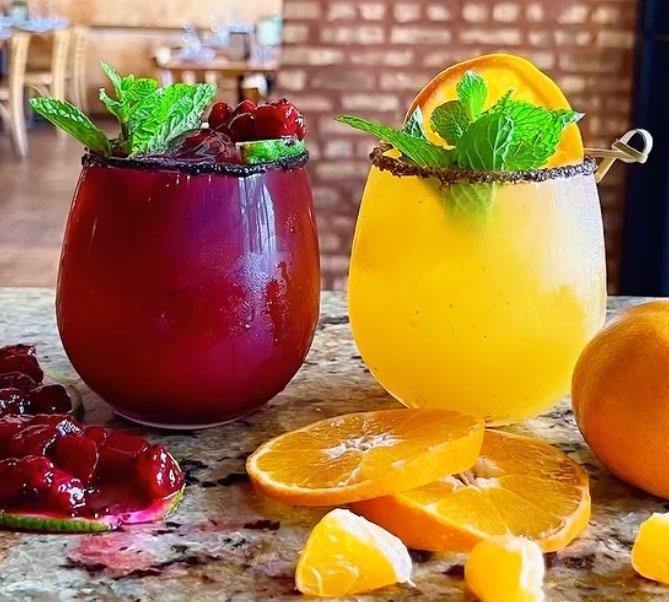
Bottomless Brunch Margaritas

“ We always try to come up with something unique — something customers can’t get elsewhere.“
TONY ESTRADA
Wednesdays. Customers also can get bottomless house Margaritas for $29.99 with the purchase of an entree during the new brunch every Friday, Saturday and Sunday. But it’s the craft approach that Estrada and mixologist Miguel Vallin take that has made Margaritas the restaurant’s best-selling cocktails and earned kudos from reporters at Daytime Chicago on WGN-TV, who in April 2024 called them “some of the best handcrafted margaritas in the city.”


The creation of the restaurant’s handcrafted cocktails begins with visits to local markets, where Estrada says he and Vallin (the pro usually pitching ideas) always look for fresh, seasonal ingredients.
For example, the answer to their question, “What goes well with apricots?” was “chipotles” — and from that, Vallin’s Apricot Chipotle Margarita was born. It appeared as one of three cocktails on the special menu El Mariachi changes monthly.
“We always run three cocktails with different flavor profiles each month — spicy, sweet, and more traditional,” Estrada explains.
The Apricot Chipotle Margarita was the spicy option on a recent menu that also included the Guava Mint Margarita



El Mariachi works with liquor companies to create three-course dinners that include a flight of the sponsoring brand’s tequila plus three El Mariachi Margaritas. It’s an opportunity to introduce customers to new Margaritas, new tequilas, new mezcals, and new dishes — all in one sitting for just $60 per person.
“The brand always comes in and explains the history of the products, does giveaways, and supplies product for the flights,” Estrada explains. Recent dinners have featured product from Casa Noble, Tanteo, Maestro Dobel, and Del Maguey Mezcal.
“The dinner with Tanteo sold out for the first day, so we added a second,” recalls Estrada, who notes that the two Margaritas customers enjoyed during those dinners included the Cucumber Jalapeño Margarita served with a ceviche-filled cucumber “cup,” and the Pineapple Chipotle Margarita paired with croquettas accented with pineapple-infused aioli.
The Maestro Dobel dinner featured a Plantain Margarita paired with a plantain toston topped with guacamole and shrimp; a 3 Chiles Margarita paired with smoked short rib in a 3 chiles sauce; and a Pear Margarita paired with a pear poached in tequila and piloncillo served over a puff pastry with vanilla bean cream.


sweet selection and the Roasted Pear Margarita made with Maestro Dobel Smoked Tequila as the more traditional offering.
“We always do one of them with a spice, chipotle for example, and the recipe is based on the peppers,” Estrada adds. “We play with them and think of the fruit [that would pair well].”
Agave syrup is another ingredient that elevates the profile of El Mariachi’s Margaritas.
“We use 21 Missions Agave. It’s 100 percent agave syrup, and we like it because it is thicker [than some other agave products on the market]. All of our Margaritas are made with a fusion of the agave syrup, water, fruit and/or chile. It’s a lot more work, but it is where you get the flavor of the cocktail.”
El Mariachi customers always can find an enticing array of Margaritas at El Mariachi. There are the Margaritas de la Casa and Specialty Handcrafted Margaritas sections of the drinks menu available every day, and the rotating menu of three specialty Margaritas offered monthly.
And then there are special options that Estrada and Vallin create for celebrating seasonal holidays — cocktails that take Estrada’s “something unique” mantra to a new level.
Last Christmas season, there were the coconutty Coquito

(described on the menu as “Creamy, coconutty, and spiced just right) and the Fresh Sugar Cane Margaritas.
Valentine’s Day 2025 brought a Rose Petal Margarita and a Roasted Beet Margarita made with mezcal.
St. Patrick’s Day often is ushered in with Valllin’s Green Apple Margarita.
And The Bandera Flight — a Cucumber Jalapeño Margarita, Coconut Paloma Blanca, and Raspberry Elderflower Margarita plated with traditional Mexican coconut candies — join the menu for Cinco de Mayo and Mexican Independence Day.

To really impress customers, it takes more than what’s in a Margarita — it’s what’s on the outside, too. That’s why Estrada and Vallin pay close attention to what is rimming every cocktail at El Mariachi.
‘We dress up our Margaritas with creative rimmers and garnishes, just like you would do a dish,” Estrada says. “We want customers to take that picture and give the cocktail that elevation!”
There are many examples from El Mariachi’s menu:
• Blood Orange Margarita rimmed with dehydrated blood orange peel, hibiscus and brown sugar
• Tamarind Tepache Margarita garnished with rim of traditional peels from tamarind blended with tajin and brown sugar
• Roasted Pear Margarita rimmed with ground roasted pear and brown sugar
• Guava Mint Margarita with toasted guava, mint and sugar rim
• Rose Petal Margarita rimmed with pink sugar rim and rose petal garnish Agave is the moistener Vallin uses to make sure salt and sugar rimmers stick to the glass.


| BY KATHLEEN FURORE
| On three Sundays in February, Chicago Empanada Mama became more than the full-service, upscale, casual dining restaurant that has attracted diners since it debuted in the city’s West Town neighborhood in June 2023. It became a culinary classroom that hosted “Empanada Fiesta: Roll, Fold, and Feast”— a 60-minute empanada-making experience that took participants on a journey that started with a history lesson about empanadas and progressed to a hands-on cooking class where they learned the fine points of rolling and filling the perfect empanada dough, and how to perfect the folding and sealing process. At the end of the class, each participant enjoyed the empanada they’d made, along with rice and a side.
“We just started doing the classes, but my weekends are getting booked up through April,” owner Inez Melendez says. “Every Sunday in March and April are already booking up!”
The class is just one of myriad ways owner Inez Melendez shares her passion for the food she learned to make from her mother Rosita, the inspiration behind Chicago Empanada Mama.
“She had this idea that food was the way to bring family and friends together,” Melendez says of her mom. “In the Caribbean, empanadas are often a staple in family holiday meals. My mother’s cooking was always the talk of the town. Many of the recipes were inspired by the beautiful times I spent in the kitchen with her, learning how to bring people together through cuisine.”
(continued on page 24)
“In the Caribbean, empanadas are often a staple in family holiday meals. My mother’s cooking was always the talk of the town. Many of the recipes were inspired by the beautiful times I spent in the kitchen with her, learning how to bring people together through cuisine.”
INEZ MELENDEZ, Chicago Empanada Mama
It’s hard to come up with a single food item that is more versatile than the empanada. It can be a snack, appetizer, entrée or dessert; be served at breakfast, lunch, or dinner; and be filled with ingredients ranging from meat and cheese to all kinds of fruit and vegetables.
The dough, which also can be made in myriad ways, essentially becomes a canvas for so many kinds of cuisines — traditional, fusion, vegetarian and vegan among them.
At Chicago Empanada Mama, that canvas is made with butter and eggs, and all of the fillings are inspired by Puerto Rican and Caribbean culture.





Take your menu to the next level with Contigo Dispenser Cheese Sauces — the perfect topping for golden French fries, Nachos, warm soft pretzels, and so much more!
Designed for convenience, our dispenser machines aren’t just for front-of-house service! Use them in the kitchen to efortlessly top dishes without the hassle of holding cheese sauce in a hot well.

The empanada menu features a cornucopia of fillings and sauces. There are options including ham and cheese; stewed and pulled chicken breasts with basil and thyme; braised garlic yucca, bell pepper, squash, onion and beans in creole sauce; eggs, chorizo and cheese; guava and cheese folded in a handmade buttery dough, air-fried to a crisp; peach cobbler; and cherry. Sauce options include Chimichurri, Tomatillo, Balsamic Vinaigrette, Garlic Sauce, BBQ Sauce and Buffalo Sauce.
But the stars of the show — the best-sellers on the menu — are the Macho Man Empanada made with ground beef, potatoes and cheese and the Lechon Empanada filled with slow-roasted garlic-rosemary pork, Melendez says.
At Chica, the Latin fusion restaurant housed in The Venetian Resort Las Vegas, empanadas take a Mexican turn in the restaurant’s very popular Quesa-Birria Empanadas.
“The Quesa-Birria Empanadas have been a staple on our menu since the opening. They are our top-selling small plate,” General Manager Samantha Clapp reports.
The ingredients are decidedly upscale, with Wagyu beef brisket that’s slow-cooked and then shredded taking center stage — or actually, center dough.
“We reduce a house-made beef consommé and fold it back in with the shredded beef then hand-wrap it in a flaky pastry
with freshly shredded, imported Mexican Oaxacan cheese,” Clapp explains.
The story of Chica’s empanadas attests to how versatile these small puffs of filled dough can be when developing menus for all dayparts.
“Originally, they were only available at dinner, but due to their popularity we now feature them all day,” Clapp adds noting that the Wagyu version is the only empanada currently served at both Chica’s Las Vegas and Miami, Florida locations.
Empanadas lend themselves to creative interpretations that make great limited time offers (LTOs), too.
Melendez, for example, collaborated with Chicago’s famed Manny’s Deli — an 80-year-old institution in the Windy City — to create a St. Patrick’s Day LTO last year.
That empanada featured Manny’s Corned Beef plus Kerrygold’s Aged Cheddar.
“St. Patrick’s Day is a big holiday in Chicago,” Melendez says, explaining how and why she came up with the idea.
Her creative approach extends to other holidays, as well.
“We try to offer different specials for different occasions, for example, we offered heart-shaped empanadas for Valentine’s Day this year,” she says.
And she’s not opposed to exploring other renditions that veer from Chicago Empanada Mama’s focus on Puerto Rican and Caribbean fare.
“We are always open to doing custom empanadas like a taco empanada or pizza empanada — let’s partner up!” Melendez says.

While empanadas can trace their origins to Galicia, Spain, today there are more varieties than anyone can count. They can be found in many varieties in more than 30 countries.
The Gamintraveler takes a quick look at seven popular empanada recipes from different regions around the globe that showcase a variety of fillings and preparation methods.
Here’s a quick recap; the full recipes can be found in the post “Love Empanadas? Discover the 7 Most Popular Empanada Recipes from Around the World.”
• Argentine Empanadas Known for their beef, olives, eggs, and raisin fillings
• Colombian Empanadas Distinctive for using cornmeal dough and fillings like pork, beef, and potatoes
• Bolivian Salteñas Juicy and slightly sweet, filled with meat, peas, and often a slice of egg
• Spanish Empanadas (Galician) Typically larger and made with various fillings like tuna, peppers, and tomatoes
• Chilean Empanadas (Empanadas de Pino) Filled with ground or minced meat, onions, olives, hard-boiled eggs, and sometimes raisins
• Venezuelan Empanadas Made with cornmeal and filled with cheeses, meats, or beans
• Puerto Rican Empanadas (Pastelillos) Featuring lighter dough and filled with seafood, meat, or cheese
• The word ‘empanada’ comes from ‘empanar,’ which means “to bread” in Spanish and Portuguese.
• There’s even a National Empanada Day, which this year falls on April 8.
• Many communities celebrate empanadas with festivals throughout the year. Coming up soon:
The 3rd Annual Tampa Bay Empanada Festival on March 29 at Harvey Park, Tampa, Florida featuring 100+ empanadas from 25+ food vendors and The Original NJ Empanada Festival on April 26 in Manville, New Jersey, complete with the battle of Empanada Festival Champions

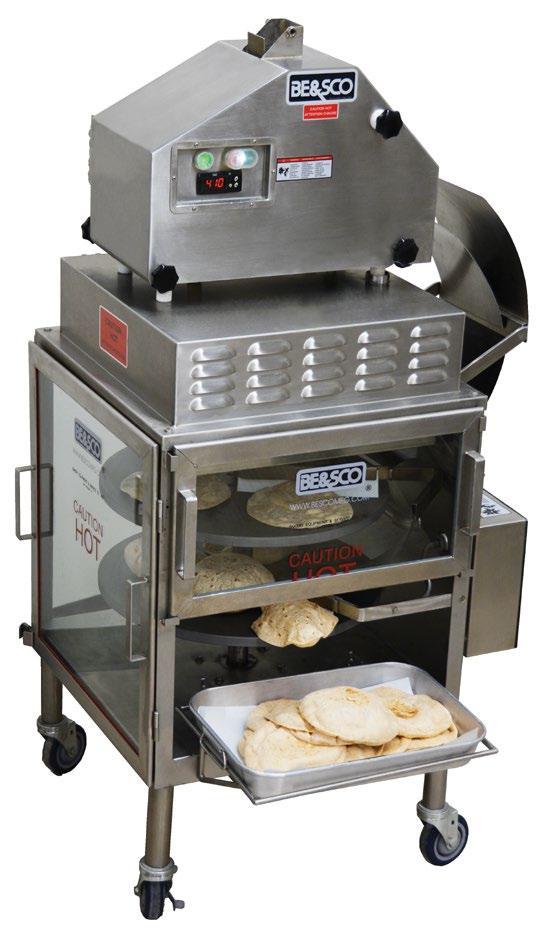




CHOPPED CHICKEN SALAD WITH MOLE VINAIGRETTE


The rich, authentic, slow-simmered flavor of true Mexican mole takes hours to achieve. But we already did that part. With DOÑA MARIA® Mole Rojo , you can skip to the fun stuff.
• Add a touch of adventure to any recipe.
• Discover bold, rich, deep flavor.
• Simply heat and start using immediately.
ELEVATE YOUR MENU IN MINUTES. LITERALLY. GET GOING


BY KATHLEEN FURORE | When Popeyes® adds a concha sandwich to its menu — something the company did when it partnered with Tequila Don Julio during Super Bowl in January 2025 — you know the concha truly has arrived on America’s culinary scene. Popeyes’ Concha Chicken sandwich featured a chicken breast fillet marinated in reposado tequila, coated with Popeyes crunchy buttermilk breading, and topped with tequila lime slaw, spicy spread, and a barrel cured pickle. And although it was a one-day LTO, the fact that a sandwich made with the Mexican sweet roll was on the menu at a chain that sits atop the fast food world shows how far conchas have come, and how far they still can go for bakers and chefs willing to get creative with flavors and fillings.
The 2025 Hospitality Trends Report presented by AF & Co + Carbonate, in fact, identifies conchas as a trend to watch this year.
“Pedigreed bakers, many of whom are first generation Latinos, are turning more attention to conchas, taking the classic shellshaped Mexican pan dulce (sweet bread) from an inexpensive sweet snack to star status,” the report says. “Bakers across the country are playing with new flavors borrowed from a global pantry, incorporating premium ingredients, adding a variety of fillings, and finding innovative ways to use the bread in different sweet and savory preparations.”
Examples include the conchas from Floracita Panaderia, a San Franciso pop-up, where conchas are made with real butter and without egg. Flavors featured at various times throughout the year include Zesty Citrus, Churro, Choco Chunk, Blue Corn, Matcha, Strawberry Hibiscus (a customer favorite), Apple Spice, Champurrado during the holidays, and Sprinkles for Pride Week.
It isn’t only the conchas rolls that are making headlines; it is how they’re being used in creative ways in sandwiches and desserts on restaurant menus.
At Burnt Bean Co in Seguin, Texas, the “La Babe” concha sandwich stacked high with smoked pulled pork and served with a chamoy barbecue sauce, chicharron, and pineapple slaw pops up every April during Fiesta San Antonio. MySA, a San Antonio local news site, has written about the sandwich, and Burnt Bean’s Facebook cover photo features “La Babe.” (continued on page 31)

No time to make your own conchas? Try collaborating with a local panaderia to create concha sandwiches and desserts to offer as limited time offers on your menu or as specials featured at your food booth during local street fairs and festivals. One example: the chorizo sandwich on a maiz azul concha created as a collaboration between Chef Eder Ramirez’s San Francio pop-up restaurant Provecho and Floracita last year




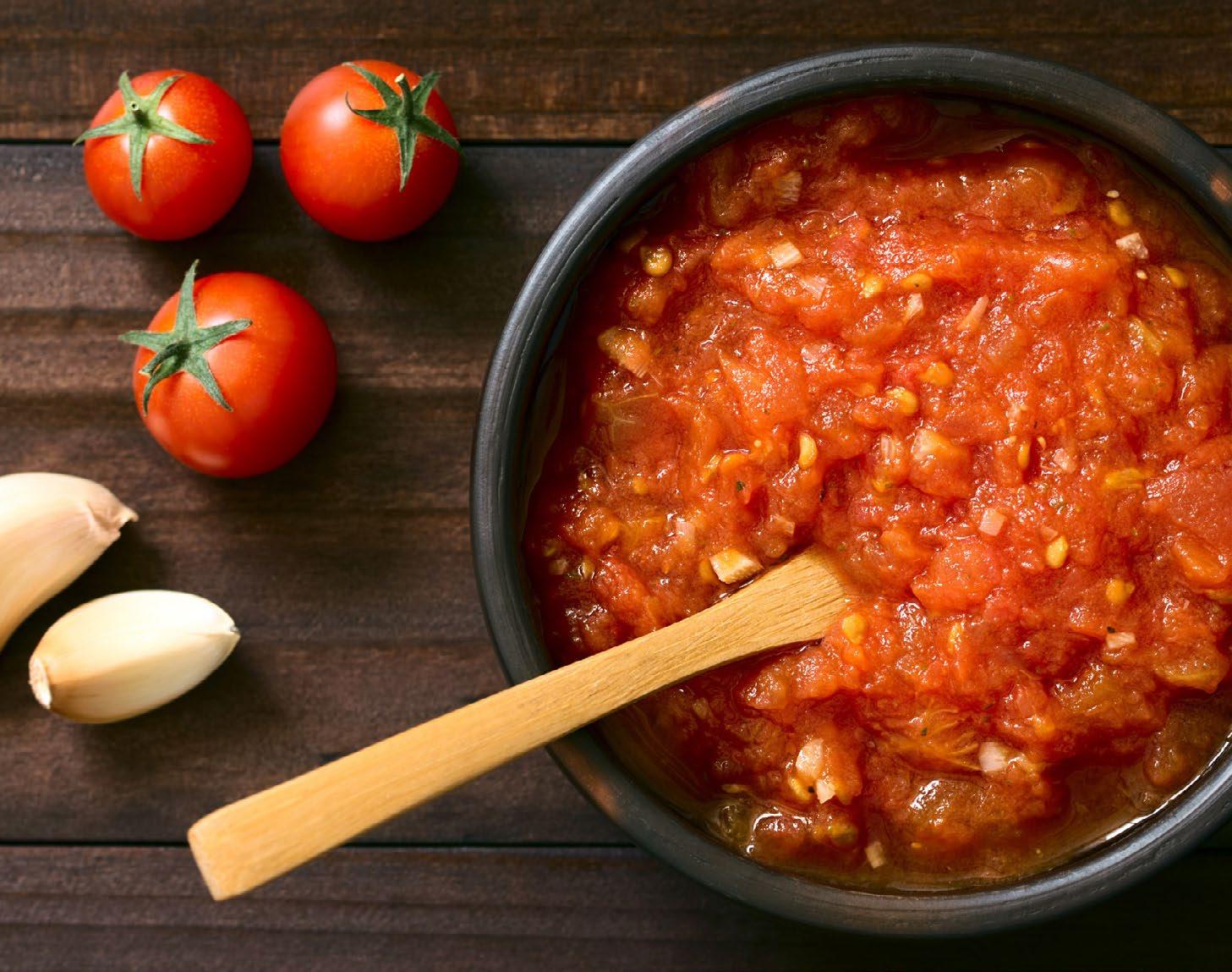
Get out your salsa-making ingredients and create a unique foodservice salsa recipe you think has the consistency and flavor to wow the judges. The grand prize winner will receive a Sammic XM-52 Immersion Blender and $750. Second and third place will receive $500 and $250, respectively. Plus the top three recipes will be featured in the NovDec issue of el Restaurante.
All readers of el Restaurante are welcome to enter the contest. The recipe must be an original recipe of your own creation. There are no restrictions on the ingredients of the recipe. All recipes will be judged on taste, creativity and appropriateness for foodservice applications.

(continued from page 28)
A similar story is playing out at El Tesoro in Atlanta, where what the restaurant describes as “Our mighty Torta Concha!” comes with a choice of any protein filling, lettuce, pico de gallo, black beans, guacamole, cotija cheese, and crema layered in a sweet pan de concha.
Another restaurant offering a concha sandwich as a limited time offer is Up Late STL in St. Louis, Missouri. The Cinco de Mayo Concha Breakfast Sandwich, made with a concha from nearby Lilly’s Panaderia, is layered with sausage, bacon, or egg plus the restaurant’s special “late sauce,” blackberry jelly and American cheese.
Cavaña in San Francisco’s LUMN Hotel also includes a concha breakfast sandwich. According to information from the AF & Co report, the sandwich is an upscale rendition made with a chorizo patty, runny egg, queso pimiento, rocoto aioli, and arugula.
Conchas are making waves as dessert offerings, too.
Cavaña’s “Dulce” menu features a Concha Cream Puff, a warmed concha filled with sweet cream.
And at Ensenada in Miami — the recently opened Florida outpost of the popular New York City Mexican seafood restaurant — Raven Simone Walker of Pachamama Helados has created a Yuzu Concha Ice Cream Sandwich as part of her seasonal ice cream program, according to a story in Eater Miami.
Has your restaurant created a special menu item made with conchas?
Let us know and we’ll feature it at elrestaurante.com.
Email Editor Kathleen Furore at kfurore@restmex.com.






| BY ED AVIS |
Does a chef’s table make sense for your restaurant?
It’s a question more and more restaurateurs are asking as they search for ways to stand out from the crowd in today’s challenging culinary marketplace.
A chef’s table is one way to do just that.
Typically located inside or near the restaurant’s kitchen, it gives guests the chance to bask in special attention from staff and watch what’s happening in the kitchen, too.
According to the Michelin Guide, the idea for a chef’s table emerged from the practice of chefs letting friends or family sit in the kitchen during regular business hours, giving them an intimate view of the working kitchen and sometimes enjoying off-menu cuisine. Eventually, enterprising restaurant owners realized people would pay for that special experience — and today’s chef’s table was born.

The idea for a chef’s table em ged from the practice of chefs le ing friends or family sit in the kitchen during regular busin s hours, giving them an intimate view of the working kitchen and sometim enjoying o -menu cuisine. MICHELIN GUIDE

Chef’s tables are found in many Mexican/Latin restaurants, particularly upscale restaurants. But they’re not all the same, either in where the table is located or the dining experience.
At dLeña, a modern Mexican restaurant in Washington, DC that is part of Chef Richard Sandoval’s portfolio, the chef’s table is four-top leather banquette tucked behind the bar. Diners have a great view into the kitchen and are served an eight-course meal at $160 per person plus a $90 wine or cocktail pairing.
dLeña’s chef’s table at dLeña offers two seatings nightly, Tuesday through Saturday. The experience includes a special menu that changes seasonally and offers dishes that are somewhat more sophisticated than those on the regular menu. Current delights include charred avocado with green apple relish, chile de arbol, peanut purée, purple watercress, and arbequina olive oil; scallops ceviche with lychee aguachile, cucumber, mango, and smoke trout caviar; and cordero a la leña, grilled lamb rack, arbol chilebean purée, plantain, house-made mole.
GATEWAY TO THE U.S. LATINO FOODSERVICE & GROCERY MARKETPLACE!

LONG BEACH, CA USA
Across the country, Valle in Oceanside, California offers its Chef’s Table Experience inside the kitchen. Guests sit at a counter directly facing the staff and are served a “unique tasting menu celebrating the finest selection of the season’s offerings,” according to promotions about the experience. The counter accommodates up to six guests. Valle holds a Michelin star and the chef, Roberto Alcocer, is a semifinalist for the James Beard 2025 Best Chef Award, so it’s no surprise that chef’s table guests are willing to pay a premium for the experience: $350 per person, plus add-ons.
And abroad, at KOL in London, the chef’s table experience unfolds in a private dining room inspired by the grand houses of Oaxaca. The space, which can accommodate up to 20 diners, overlooks the kitchen, where a dedicated team of chefs prepare dishes that allow diners to explore tasting menus of the elevated Mexican cuisine at lunch and dinner.
While chef’s tables normally are found in these kinds of upscale Mexican restaurants, the concept could be applied to any restaurant whose customers are interested in enjoying a more intimate dining experience and more focused attention than they can get in a regular visit.
Here, Chef Santiago Lastra, co-owner of KOL, shares his experience in offering a chef’s table with el Restaurante readers:

Why did the founders of KOL decide to include a chef’s table as part of the restaurant?
Before opening KOL, we used to have a test kitchen in west London, where we developed the first dishes of KOL for almost a year. During the design process, we explored many concepts and distributions for KOL. In the end, it made sense to keep a space where we could continue with the R&D of KOL and share our food with bigger parties.
How often is the chef’s table occupied?
It depends on the season, but in general, quite often, we do between four and six private events a week, including lunch and dinner. We always recommend the space for 12+ people; however, there have been cases when we have had guests come with smaller parties and have the best time. The maximum we can accommodate in the room is 20 people. It’s an amazing atmosphere when the room is at maximum capacity.
Tell us about the experience customers receive at the chef’s table.
The chef’s table set-up and ethos are similar to the main restaurant; it’s designed for you to feel at someone’s house in the south of Mexico. The kitchen is close by, and we always encourage people who are interested in cooking to go in and say hello to the chefs.
“The kitchen is close by, andwe always encourage people who are interested in cooking to go in and say hello to the chefs.”
CHEF SANTIAGO LASTRA, KOL
As the chef’s table works on a private hire basis, it gives us the opportunity to curate the experience for the party as much as we can. We want to make every experience special in its unique way.
Do you find that the customers who reserve the chef’s table are people celebrating special occasions, or just “foodies” who relish the experience?
We have a bit of a mix, but it’s definitely more of a celebration space. We host birthdays, engagements, graduations, and Christmas parties. We do have people who convince their big group of friends to join them for a big dinner, too.
What have you learned about operating a chef’s table that you wish you had known when you launched it?
When we first launched the chef’s table, we had a different menu than the restaurant, with new ingredients and ideas coming up every day. It was hard to operate and even harder to explain to the guests what the concept behind it was exactly. I think simplicity is the highest form of sophistication and being clear to guests on what our offering is and what’s the value in it.

| BY KATHLEEN FURORE | Margaritas
are probably the most popular cocktails being made behind your bar. But there’s a trend mixologists and other bar pros see heating up the craft cocktail scene.
“With the soaring popularity of the Margarita, there’s been a noticeable shift in consumer interest towards the Daiquiri. This classic cocktail is capturing attention, particularly with its intriguing origins in the early 20th century, where it was discovered in the town of Daiquiri in Santiago de Cuba,” says Ray Lombard, executive vice president and general manager, Craft Spirits, at Southern Glazer’s Wine & Spirits. “On a hot day in the iron mines a fresh squeezed lime over sugar and crushed ice was topped with Bacardi rum and the Daiquiri was born. Bartenders and cocktail enthusiasts alike are rediscovering the charm of this refreshing beverage.”
And that means they’re discovering — or perhaps rediscovering — the power of rum.
At Miss B’s Coconut Club in San Diego’s Mission Beach neighborhood rum isn’t just a spirit — it’s the heartbeat of the bar, where cocktails celebrate “the depth and versatility of cane spirits through house-blended varieties, immersive tasting flights, and island-inspired cocktails.”

Standouts include the Tortuga Heater, a mix of barrel-aged rum, rye whiskey, Mandarine Napoléon, sherry, and house maple bitters; and the Welcome to the Caribe, a blend of white rum, Coco López, coconut water, cordial, and lime.
“We have always had a strong Daiquiri following at Miss B’s, but I have recognized that more and more people are understanding what is in a classic Daiquiri, which is a huge step in the right direction,” General Manager Eddie Jurado says. “You could only imagine guests’ faces when we would present a refreshing, classic lime Daiquiri in a coupe glass, when they were expecting a variation of some flavored, sugary, frozen concoction.”
Miss B’s “Go-to” Daiquiri is made with 1.5 oz. rum (suggested spirit: Planteray Pineapple Stiggins) 0.5 oz. pear liqueur (suggested spirit: Belle de Brillet) ; 0.5 oz. grapefruit juice; 0.5 oz. lime juice; and 0.75 oz. vanilla orgeat.
Another fun trend Jurado says is catching on: the Snaquiri, a shot sized Daiquiri.
And while Assistant Beverage Director Brianna Rahoy says Margaritas “are definitely hard to beat, especially in San Diego where tequila is hands down the most popular spirit,” two of Miss B’s most popular cocktails feature rum.
The Rum Cannonball combines a house rum blend plus trini
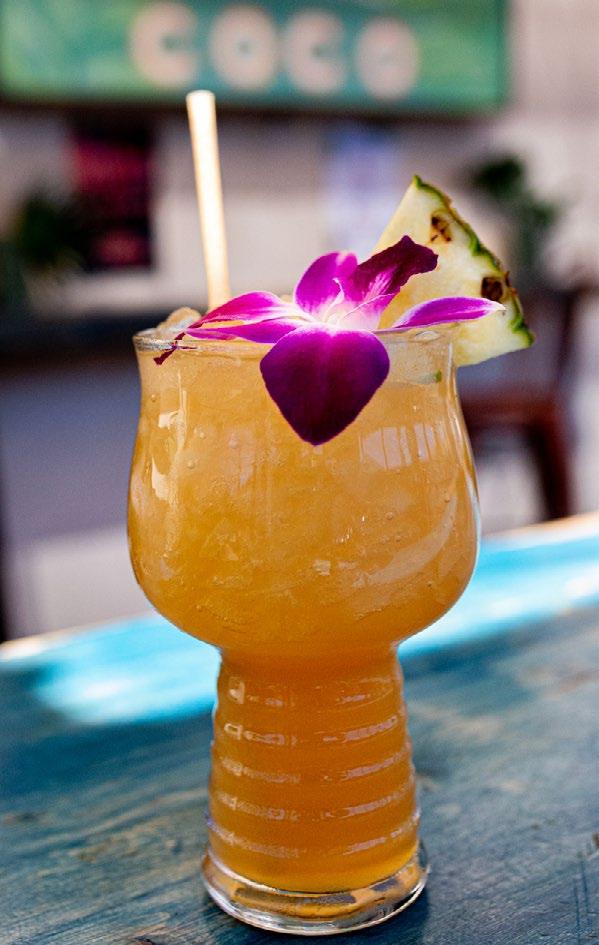
“The b t way to incorporate rum into a Mexican R taurant is to use one of the fine agricole rums the country produc . My favorite in that category right now is Pa anub made in the north n highlands of Oaxaca, wh e a sparsely inhabited subtropical climate produc some of the b t sugar cane on earth.”
ROB MCSHEA, Miss B’s Coconut Club

rum, fresh lime juice, fresh pineapple, falernum, orgeat, and demerara syrup in what Rahoy describes as “our House Mai Tai.”
The Caribe Welcome mixes white rum, Coco Lopez, coconut water, cordial and lime. As the story goes, Ramón “Monchito” Marrero created a new cocktail to welcome guests to the Caribe Hilton in 1954. Originally non-alcoholic, he eventually decided to add local rum — and the rum-based Caribe Welcome was born.
There are ways mixologists can effectively incorporate rum into cocktails to give them a decidedly Mexican twist.
“The best way to incorporate rum into a Mexican Restaurant is to use one of the fine agricole rhums the country produces,” Rob McShea, Miss B’s beverage director, says.
While other rums are made from a sugared solution comprised mostly of watered down molasses, rhum agricole — which is similar to Cachaça — is distilled from freshly squeezed sugarcane juice.
“My favorite in that category right now is Parranubes made in the northern highlands of Oaxaca, where a sparsely inhabited sub-tropical climate produces some of the best sugarcane on earth,” explains McShea, who describes two ways to incorporate the spirit. “First, I would use this spirit to make a traditional Mai Tai, with a house made orgeat. Orgeats are typically made with almond; however, other nuts can be used to provide a
MISS B’S COCONUT CLUB has made a splash in San Diego with its Caribe Cartel Rum Flight Club — an offer the restaurant describes as “a high-spirited adventure where guests embark on a journey through the world’s best rums, collecting regional pins along the way.”
There’s even a prize for those who complete the journey: They earn the title “Caribe Kingpin” and take home a bottle of Miss B’s exclusive Great Idea house-blended rum!

A lot, according to Eddie Jurado, the manager Miss B’s Cocktail Lounge in San Diego, who says verbiage can play a key role in making rum relatable to guests who typically wouldn’t opt for rum-based drinks.
“Find similarities between rum and tequila and use that to your advantage when describing rum to the guest,” Jurado suggests. “For example, ‘Try this really smooth aged rum that has notes of vanilla and baking spices. It has a lot of similar tasting notes to a high end añejo or reposado tequila.’”
Another idea: call a Daiquiri a Rum Margarita.
“I have seen that used on menus and people will gravitate towards that over saying daiquiri,” he says.
more complex flavor. Second, I’d let the spirit sing in a straightforward Daiquiri. The modifier ingredients in these particular cocktails are similar to those used in Margaritas.”
That category of rum is one Lombard also recommends.
“This unique category of rum, known for its distinct flavor profile, is starting to make waves as more consumers become educated about its origins and production methods,” he says. “It’s exciting to see this lesser-known rum variety gain traction and appreciation.”
Using ingredients with flavor profiles that mesh with dishes featured on the menu is another way to ramp up the selection of rum-based drinks at Mexican and Latin restaurants.
A drink on the February menu at Death & Co. in Los Angeles, Denver, New York and Washington, D.C. is one example. The Drive-In Theatre by Josh White was one of four cocktails created to honor the excellence and legacy of Black bartenders during Black History Month. Showcased with the recipe on Instagram, it featured Equiano Light Rum, Sango Agave Blanco, St. George Green Chili Vodka, Nixta Elote Liqueur, Coco Lopez, orange juice, and lime juice — ingredients that clearly evoke the flavors and spirt of Mexico.
Lombard also cites “a fascinating movement towards infused craft rums” showing up at Mexican and Latin restaurants in creative ways.
“One standout example is Copalli Cacao Infused Rum from Belize. This cacao-infused rum provides a wonderful twist to the classic Espresso Martini, offering a rich and flavorful experience that’s been very well received,” Lombard says “Exploring new flavor combinations and presentation styles can truly elevate the rum cocktail experience for patrons.”

San Diablo Artisan Churros.
Wholesale Take & Fry Churros let you elevate your dessert menu without the time and labor involved in making churros from scratch. The awardwinning dough arrives frozen, in hollow churro form, ready for frying and filling – just deep fry at 375°F for 3 to 5 minutes until golden brown. Churros come in packs of 100 frozen. Cups, Cinnamon Sugar, and Dulce de Leche filling also available. sandiablochurros.com

Kuko’s M Foods. Adobos, marinades, seasonings and spices available in foodservice sizes are just some of the products Kuko’s offers. Items include concentrated Birria Adobo Marinade Paste, Al Pastor Adobo Paste, Barbacoa Marinade Adobo Chili Paste, Lemon Pepper Adobo, Achiote Annatto paste and more. 805-257-2314; kukosmfoods.com
This company offers fresh Huitlacoche in season, from Mexico, kept fresh in a facility near Los Angeles International Airport. Customers can e-mail/DM by Sunday for Wednesday delivery in the Los Angeles area, and the company will ship overnight for Friday delivery in the rest of the U.S. Email carolina@ huitla.com or DM @huitlacoche.bodega; huitla.com


H.S., Inc. The company’s line of servingware is perfect for Mexican restaurants! Products include molcajetes; thermally insulated tortilla servers, and the new Tortilla PleezerTM that combines the thermal qualities and durability of the original server with the added benefit of patented elevators that keep the tortillas slightly raised; taco cradles that hold 3 tacos to keep them separate from rice and beans on the plate; taco servers with 4 compartments; chip and salsa servers; and a new cactus style salsa caddie. Custom colors, plus custom logos on the tortilla server are also available. 405-2396864; sales@hsfoodservers.com; hsfoodservers.com
Empirical Cilantro. Empirical has taken fresh, aromatic cilantro and reimagined it as a bold, versatile standalone spirit. It is built on a base of light French Wheat, showcases cilantro, and has notes of tomatillo. Whether shaken into a Margarita or simply topped with soda, this 38% ABV spirit delivers a fresh perspective on flavor, distilled with the same curiosity that has made Empirical one of the most innovative names in spirits today. us.empirical.co

ON MARCH 23RD, NATIONAL TAMALE DAY will be celebrated in restaurants, tamale shops, and homes all across the country. It’s a day founded in 2015 by tamale chef Richard Lambert, owner of Richard Lambert Tamales in Santa Barbara, California, and National Tamale Day Chairman.
“I was surprised when I found out there was no National Tamale Day and we set about to change that,” Lambert explains.
The theme for this year’s National Tamale Day is breakfast tamales. According to Lambert, over the years breakfast has become known as “tamale time” in Mexico.
In recognition of its morning popularity in Mexico, Lambert has introduced a breakfast tamale to coincide with National Tamale Day this year.
“We wanted to create a tamale with some popular breakfast flavors that also work well with our signature salsa verde,” Lambert says. “After a series of taste-tests, we chose breakfast sausage, bacon, caramelized sweet onion, diced potato, red and green bell pepper all blended together with our salsa verde, then topped with grated sharp cheddar cheese. We like to serve ours with fried eggs and pico de gallo.”
Here, Lambert shares his recipe with el Restaurante readers.
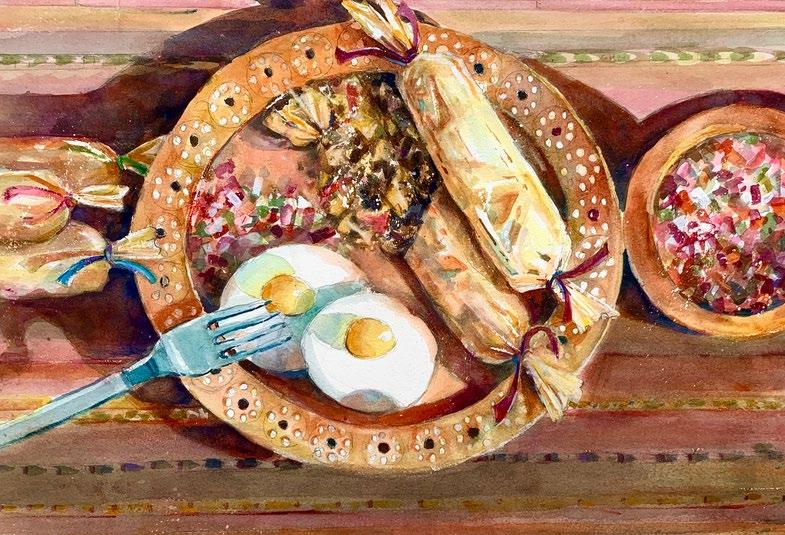
Makes 24 tamales
3 Spanish onions or sweet onions, medium size, thinly and evenly sliced
1 lb. ground breakfast sausage
1 lb. bacon, cut strips into ½” pieces
3 russet potatoes, medium size, small dice
3 bell peppers (2 green, 1 red), small dice
1 lb. sharp cheddar cheese, grated
2½ - 3 c. tomatillo salsa
3 lbs. masa preparada
24 sheets of parchment paper
48 (10-inch) lengths of raffia ribbon to tie ends of tamales
In a mixture of butter and olive oil, caramelize the onions. Place sliced onions in a large cast iron pan heated to medium-high. When the onions have softened a bit (about 3 minutes), lower heat and sauté onions for about 20 minutes, turning frequently. If onions begin to
stick to the pan, deglaze with broth or water. The onions are ready when they have developed a rich caramel color. Add a teaspoon of salt at the end of the process then set onions aside.
Fry bacon pieces and sausage in separate pans and set aside.
Place diced potatoes in a large pan and fry in 3 to 4 tablespoons of bacon drippings, adding diced red and green bell peppers after 2 to 3 minutes. The potatoes are done when they are no longer crunchy, but still firm.
Combine bacon, sausage, and caramelized onion with potato mixture. Add ⅓ of the tomatillo salsa at a time until ingredients are blended. Place filling in refrigerator until ready to assemble tamales.
Grate half the cheddar cheese;
refrigerate the rest. It is easier to work with cold cheese, so grate more as needed.
Prep masa in a mixer, using the paddle at a low speed for 1 to 2 minutes to bring the masa to a spreadable consistency. Place masa on a sheet pan covered with foil. Position masa, cheese, filling, wrapper and ribbon ties on a flat working surface.
Spread 3 to 4 tablespoons of masa onto a parchment paper sheet using a masa spreader. Keep masa 1½” away from the right and left sides, and about 4 inches from the top (along the 9-inch edge).
Bring masa all the way to the lower edge (the one closest to you). Place 3 to 4 tablespoons of filling on masa near the edge closest to you and sprinkle 2 to 3 tablespoons of grated cheese over filling. Carefully roll tamale (going away from you) and tie each end of wrapper with a ribbon tie.
Place tamales in a steamer and steam for 1½ to 2 hours. Test doneness of masa by peeling back the wrapper a little to see if the masa is cooked through. It’s best to let the masa firm up a bit by letting the tamales rest 10 minutes before serving.










